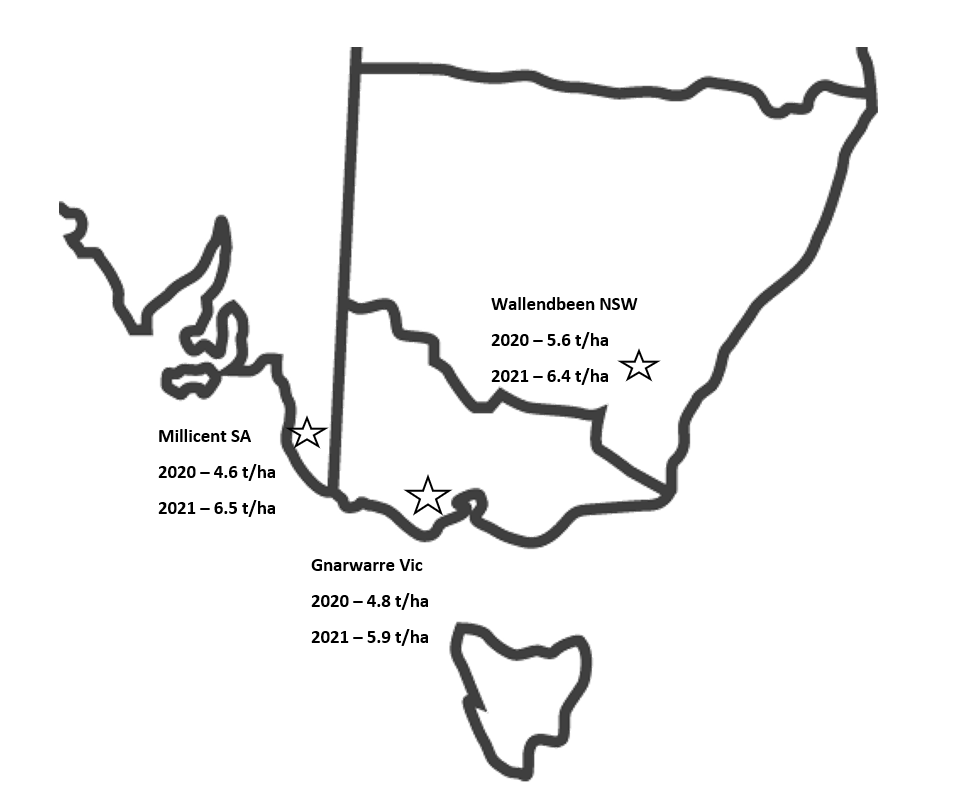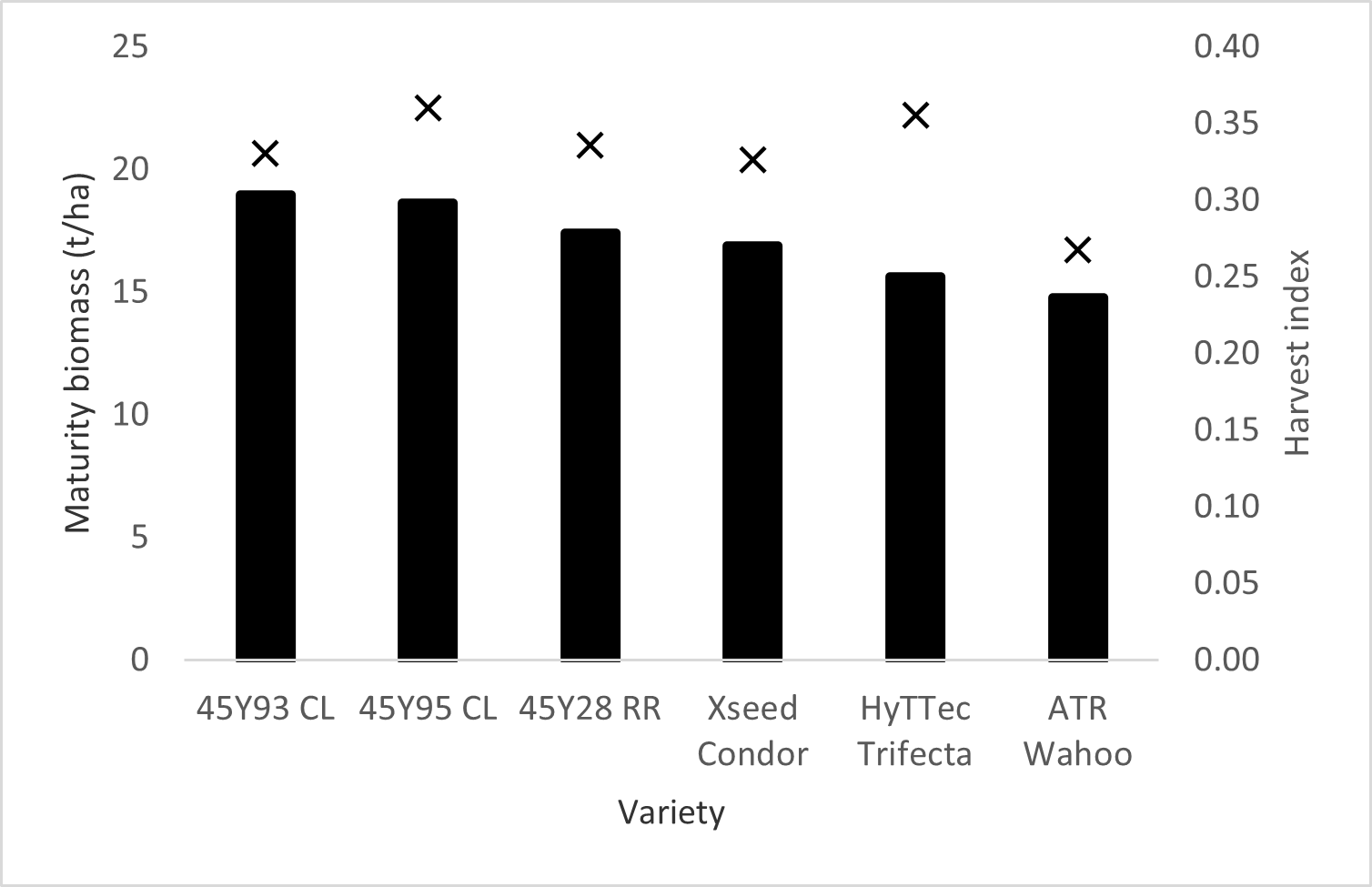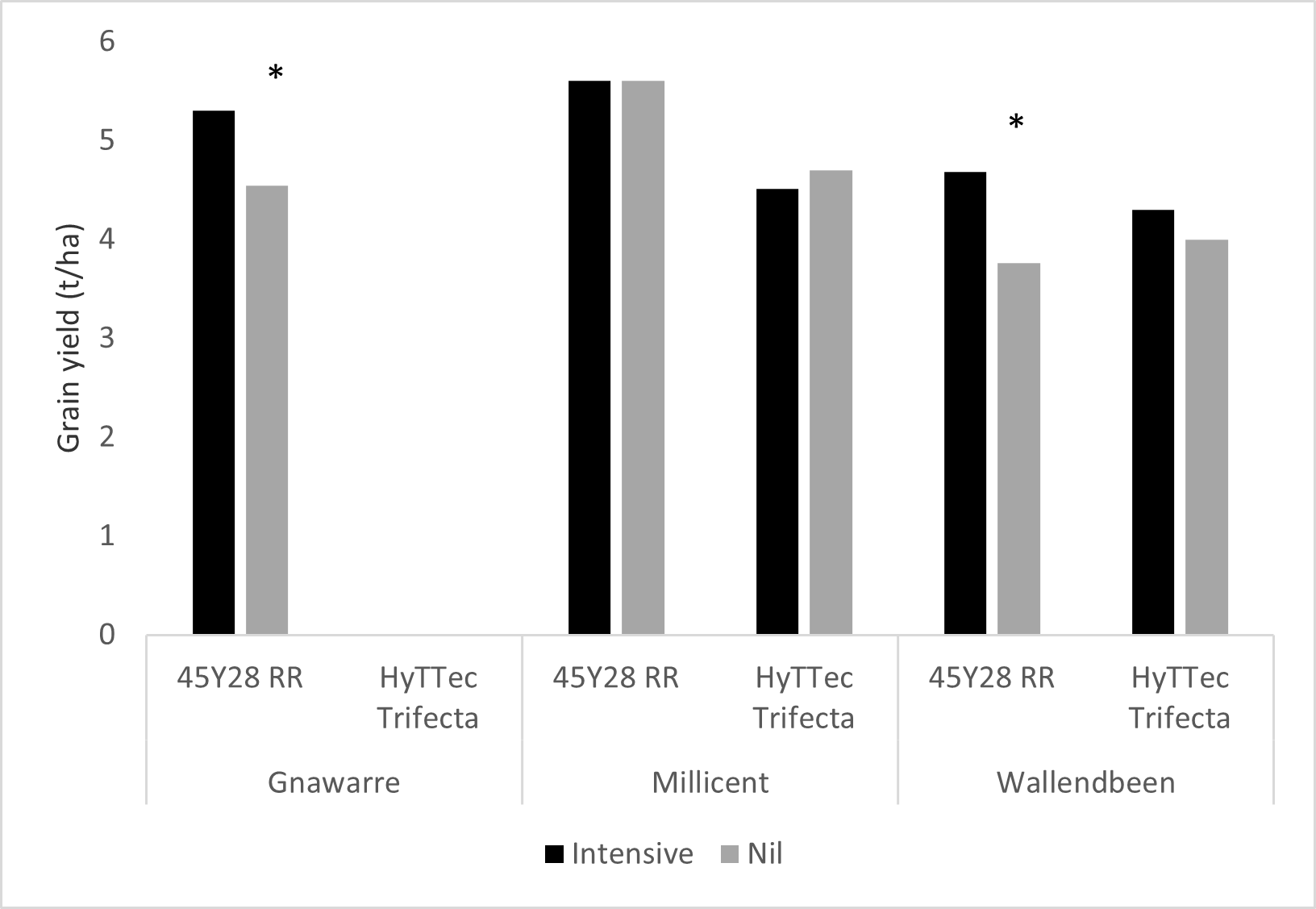Hyperyielding crops lifts canola yield above 6 t/ha
Author: Rohan Brill (Brill Ag), Darcy Warren (FAR Australia), Tracey Wylie (FAR Australia), Kat Fuhrmann (FAR Australia), Aaron Vague (FAR Australia), Max Bloomfield (FAR Australia), Kenton Porker (FAR Australia), Nick Poole (FAR Australia) | Date: 02 Aug 2022
Take home messages
- Grain yield reached well over 6 t/ha at Millicent and Wallendbeen in 2021, 1 t/ha above the highest yields observed in 2020
- Yield plateaued from nitrogen application either below or up to 150 kg/ha applied N
- The application of animal manure lifted yield by a further 11-18% above the maximum yield from applied fertiliser N
- Variety choice has a major impact on achieving Hyperyields, with 45Y95 CL being the standout variety in 2021
- Further research will determine the mechanisms behind the strong yield response from animal manure and how nutrition can drive Hyperyields of canola.
Background information from 2020
The canola component of the GRDC and FAR Australia Hyperyielding Crops project commenced in 2020 with sites at Gnarwarre, Victoria; Millicent, South Australia; and Wallendbeen, NSW. The focus has been on determining the management factors including variety choice, nutrition, disease control and plant density required to achieve a canola yield of 5 t/ha. Variety choice and nutrition were the two most important factors driving canola yield in these high yielding environments in 2020, with fungicide and seeding rate less important. Highest yields were at Wallendbeen with 5.6 t/ha of 45Y28 RR with 225 kg/ha N applied. At Gnarwarre, highest yield was 4.8 t/ha of 45Y28 RR with 106 kg/ha N applied plus 5 t/ha pig manure. At Millicent highest yield was 4.6 t/ha of 45Y93 CL. All results from 2020 are available at: https://faraustralia.com.au/wp-content/uploads/2021/04/210325-HYC-Project-2020-Results-Canola-Final.pdf.
2021 Hyperyielding canola trials
Trials with a similar focus were conducted in 2021 in the same environments as 2020. Yields were higher in 2021 at all sites, with two of the three sites achieving a grain yield of 6 t/ha, well above the target yield of 5 t/ha (Figure 1). This paper outlines the key management strategies to achieve these very high yields at each site.
Figure 1. Grain yield of the highest yielding canola treatments at three sites in 2020 and 2021.
Methodology
This paper primarily reports on two key trial series (Table 1). The first series is a Genotype * Environment * Management (GEM) trial, which were split into separate winter and spring trials with three management strategies (Low, Medium and High Input) applied to each variety (blocked by herbicide tolerance) at three locations; Gnarwarre, Millicent, and Wallendbeen (Site descriptions in Table 2). The second trial series was a nutrition trial, again split into separate spring and winter trials with six nutrition treatments, focusing on nitrogen management and the addition of animal manure.
The paper also summarises results of plant density and disease management trials conducted in 2021.
Table 1. Variety entries and treatments in a canola G * E * M trial and canola nutrition trial, conducted at three sites in 2021.
GEM trial series | Nutrition trial | ||||
|---|---|---|---|---|---|
Spring Varieties | Winter Varieties | Treatments | Spring Variety | Winter Variety | Treatments# |
ATR Wahoo | Hyola 970CL | Low Input: Seed = Maxim® XL | 45Y28 RR | Hyola Feast CL | 0 kg/ha N |
HyTTec Trifecta | 75 kg/ha N | ||||
45Y93 CL | Medium Input: Seed = Maxim XL | 150 kg/ha N | |||
45Y95 CL | Hyola Feast CL | 225 kg/ha N | |||
45Y28 RR | High Input: Seed = Saltro® Duo | 300 kg/ha N | |||
Condor TF | 225 kg/ha N + animal manure* | ||||
*Manure applied – 6.7 t/ha pig manure at Gnarwarre and Millicent (2.7% N, 1.3%P) and 3 t/ha chicken manure at Wallendbeen (3.3% N and 0.7% P).
#N Applications were split 50% at 6-Leaf stage and 50% at bud visible stage.
Table 2. Site description for three Hyperyielding Canola sites in 2021.
Location | Region | Average rainfall | Elevation | Soil type | Available N at sowing | Organic Carbon | Colwell P | Applied P | Applied S |
|---|---|---|---|---|---|---|---|---|---|
Gnarwarre | Southern Victoria | 600 mm | 190 m | Sodic Vertosol | 70 kg/ha | 1.4% | 34 mg/kg | 22 kg/ha | 30 kg/ha |
Millicent | South-East SA | 710 mm | 20 m | Organosol | 173 kg/ha (0-10 cm) | 9.7% | 56 mg/kg | 22 kg/ha | 30 kg/ha |
Wallendbeen | South-West Slopes NSW | 680 mm | 540 m | Red Ferrosol | 340 kg/ha (0-90 cm) | 2.0% | 63 mg/kg | 30 kg/ha | 30 kg/ha |
Results and discussion
Nutrition trials
In the Spring Nutrition trials, yield from the application of N alone (as urea) plateaued at 150 kg/ha at Gnarwarre and 75 kg/ha at Millicent (Table 3), with no yield increase from applied N at Wallendbeen which had a starting nitrogen of 340 kg/ha in the top 90 cm. In the Winter Nutrition trials, there was no yield response from applied N (urea) at either Gnarwarre or Wallendbeen (Table 4).
Despite high starting fertility levels and saturated N responses, there were still strong responses to applied animal manure over and above high rates of applied N. This response was observed in all spring trials and one winter trial, Gnarwarre. The yield response from manure in the spring trials ranged from 11% at Wallendbeen to 18% at Gnarwarre and in the winter trials from nil to 17.5%. The yield response from nutrition was due to an increase in grain number (per unit area) rather than an increase in grain size.
At Wallendbeen (NSW) there was a response to nitrogen observed by the flowering stage in winter canola with up to 14 t/ha biomass produced (Figure 2). By maturity, lodging followed a similar trend as flowering biomass with very high N input plots being completely lodged. With a shorter duration from sowing to flowering, there was no response to N observed at the flowering stage (average 7 t/ha biomass) in spring canola and minimal lodging of plots. In NSW canola environments, winter canola is more suited to dual purpose farming systems, turning the excess vegetative biomass (up to 7 t/ha more than spring canola) into livestock production. Note there would be major animal health implications with the high nitrogen inputs reported here.
It is exciting to see such strong yield responses from nutrition above the response from applied N (urea) alone, especially to yield levels above 6 t/ha. The challenge for the project team is to better understand the reason for the strong yield response from animal manure and how that can be replicated cost-effectively across the wider grains industry.
Table 3. Effect of nutrition (applied N and animal manure) on 45Y28 RR canola at three Hyperyielding Canola sites in 2021. Shaded cells denote highest yield in trial.
Kg/ha N applied as urea | Gnarwarre Vic | Millicent SA | Wallendbeen NSW |
|---|---|---|---|
0 | 4.0 | 4.9 | 4.5 |
75 | 4.5 | 5.6 | 4.4 |
150 | 4.9 | 5.8 | 4.6 |
225 | 5.1 | 6.1 | 4.5 |
300 | 5.0 | 5.8 | 4.5 |
225 + Manure | 5.9 | 6.5 | 5.0 |
l.s.d. (p<0.05) | 0.36 | 0.56 | 0.32 |
*Manure applied – 6.7 t/ha pig manure at Gnarwarre and Millicent (2.7% N, 1.3%P) and 3 t/ha chicken manure at Wallendbeen (3.3% N and 0.7% P).
#N Applications were split 50% at 6-Leaf stage and 50% at bud visible stage.
Table 4. Effect of nutrition (applied N and animal manure) on Hyola Feast CL canola at two Hyperyielding Canola sites in 2021. Shaded cells denote highest yields in the trial.
Kg/ha N applied as urea | Gnarwarre Vic | Wallendbeen NSW |
|---|---|---|
0 | 3.8 | 3.8 |
75 | 3.9 | 3.7 |
150 | 4.1 | 3.6 |
225 | 4.1 | 3.8 |
300 | 4.0 | 3.7 |
225 + Manure | 4.7 | 3.5 |
l.s.d. (p<0.05) | 0.51 | n.s. |
*Manure applied – 6.7 t/ha pig manure at Gnarwarre and Millicent (2.7% N, 1.3%P) and 3 t/ha chicken manure at Wallendbeen (3.3% N and 0.7% P).
#N Applications were split 50% at 6-Leaf stage and 50% at bud visible stage.
Figure 2. Flowering biomass (t/ha) and lodging (1 = standing, 9 = flat) of Hyola Feast CL winter canola at the Wallendbeen site (NSW) in 2021 in response to increasing rates of nitrogen and animal manure.
*Manure applied – 3 t/ha chicken manure at Wallendbeen (3.3% N and 0.7% P).
#N Applications were split 50% at 6-Leaf stage and 50% at bud visible stage.
GEM trials
There were large differences between varieties in the spring GEM trial, with a small response from management at Gnarwarre and Wallendbeen and no management response at Millicent. At Wallendbeen there was an average yield response of 0.3 t/ha in the High Input management versus Medium and Low Input. At Gnarwarre there was 0.3 t/ha higher yield in the High Input management compared to Low Input management.
At Millicent and Wallendbeen, 45Y95 CL was the standout variety with yield of 6.4 t/ha (averaged across management levels) (Table 5). This yield is 28% higher than the target yield of 5 t/ha and highlights what can be achieved with canola when seasons, variety choice and management all align. The addition of manure to improve crop nutrition may raise the bar even higher for canola and this will be tested in the GEM trial in future years.
The high yield of 45Y95 CL at Wallendbeen in 2021 was due to a combination of high biomass (18.6 t/ha) and high harvest index (0.36) (Figure 3). Canola harvest index will always be lower than a cereal crop as the seed is more energy dense. When allowing for the ‘glucose equivalents’ of the canola at Wallendbeen in 2021, the harvest index would equate to approximately 0.6 in wheat.
45Y28 RR was the highest yielding variety in the GEM trials at Gnarwarre where Clearfield® varieties were not included. However, 45Y95 CL was the highest yielding variety in the adjacent Spring Screen trial.
In the winter GEM trials, Hyola Feast CL yielded higher than Hyola 970CL at Wallendbeen but there was no yield difference between the two at Gnarwarre (Table 6). There was no yield difference between the management levels in the winter GEM trial at either site.
Table 5. Effect of variety choice on grain yield (averaged across three input levels) in Spring G * E * M trial at Gnarwarre, Millicent and Wallendbeen in 2021. Shaded cells denote highest yields in the trial.
Gnarwarre Vic | Millicent SA | Wallendbeen NSW | |
|---|---|---|---|
ATR Wahoo | 3.5 | 3.3 | 3.6 |
HyTTec Trifecta | 3.9 | 4.4 | 5.2 |
45Y95 CL | * | 6.4 | 6.4 |
45Y93 CL | * | 5.7 | 5.6 |
45Y28 RR | 4.5 | 5.1 | 4.9 |
Condor TF | 3.9 | 5.1 | 5.2 |
l.s.d. (p<0.05) | 0.21 | 0.34 | 0.36 |
Table 6. Effect of variety choice on grain yield (averaged across three input levels) in Winter G * E * M trial at Gnarwarre, Millicent and Wallendbeen in 2021. Shaded cells denote highest yields in the trial.
Gnarwarre Vic | Wallendbeen NSW | |
|---|---|---|
Hyola Feast CL | 4.3 | 3.8 |
Hyola 970 CL | 4.0 | 3.4 |
l.s.d. (p<0.05) | n.s. | 0.34 |
Figure 3. Maturity biomass (t/ha) (solid bars) and harvest index (x) of six canola varieties in GEM trial at Wallendbeen, NSW in 2021.
Canola plant density
Trials have been conducted on winter and spring canola with plant population targets of 15 to 75 plants/m2. The response to plant density has been minimal despite large visual differences early in the season. Only at Millicent in SA has there been a consistent effect of plant density with a yield penalty for 15 plants/m2 compared to 30-75 plants/m2. At Wallendbeen in NSW there has been no difference in yield observed from 15 to 75 plants/m2. Growers looking to target plant population of ~15 plants/m2 should pay strict attention to seed size and their expected establishment rates. Large seed combined with high establishment losses may mean that sowing rate (kg/ha) should not be reduced greatly.
Canola disease management
Disease management trials have focussed on varietal resistance and fungicide management. A range of fungicide timings and products have been used but the overall response to fungicide has not been strong.
At Wallendbeen in 2021, Intensive fungicide management (Saltro® on seed + Prosaro® at 6-leaf + Aviator® 20% bloom + Prosaro at 50% bloom, all applied at highest label rates) yielded 0.9 t/ha more than where Nil fungicide was applied to the Resistant/Moderately Resistant 45Y28 RR (Blackleg Group BC) (Figure 4). There was no yield difference between Intensive and Nil fungicide when applied to the Resistant HyTTec® Trifecta (Blackleg Group ABD).
Despite a favourable spring, sclerotinia was only present at low levels at Wallendbeen in 2021 with 1.5% of plants infected in the untreated control. Saltro Duo on seed reduced blackleg crown canker but even where no seed treatment was applied, blackleg severity (% of stem cross section infected with blackleg) was less than 5% for 45Y28 RR and HyTTec Trifecta. The greatest difference between the varieties was with pod blackleg infection, with 1.8% of pod area infected by blackleg in the untreated HyTTec Trifecta versus 6.8% for 45Y28 RR. Intensive fungicide management reduced pod blackleg infection to 2.1% in 45Y28 RR.
Figure 4. Effect of fungicide program (Intensive versus Nil) on grain yield of 45Y28 RR at Gnarwarre, Millicent and Wallendbeen and on HyTTec Trifecta at Millicent and Wallendbeen in 2021. Intensive fungicide management = Saltro Duo on seed + Prosaro 450 mL/ha at 6-leaf stage + Aviator Xpro 800 mL/ha at 20% bloom + Prosaro 450 mL/ha at 50% bloom.
* Indicates a significant difference at p=0.05.
Discussion and conclusion
There were several major stories to emerge from 2021 Hyperyielding Canola trials:
- Yield levels were above even the most optimistic forecasts for canola – 6 t/ha should be a commercial target for industry and 7 t/ha will be the next frontier for research in these environments.
- Nutrition is not just about applied nitrogen – strong responses from animal manure showed the importance of nutrition to push yields to new levels. This needs to be further investigated by the project team to determine if the yield response from manure is due to its slow-release nature or from nutrients such as phosphorus and potassium that are applied along with nitrogen in animal manure. Also noteworthy was that despite very high yields observed in 2021, the response to increasing nitrogen rates was not strong. N response usually plateaued at applied rates <150 kg/ha, indicating that much of the crops N requirement came from soil reserves rather than fertiliser inputs.
- Like 2020, variety choice had a large impact on grain yield outcomes. 45Y95 CL was the standout variety across the three sites in 2021.
- Fungicide management and plant density generally had less of an effect on grain yield than variety and nutrition and these factors don’t appear to be the factors that will open new yield frontiers in canola.
For further detailed results from 2021, including results on cereal crops, please visit https://faraustralia.com.au/wp-content/uploads/2022/04/HYC-2021-Results-FINAL.pdf
Acknowledgements
FAR Australia and Brill Ag gratefully acknowledge the investment of the Grains Research and Development Corporation (GRDC) for the Hyper Yielding Crops Project
Collaborating partners acknowledgement
FAR Australia gratefully acknowledges the support of its research and extension partners in the Hyper Yielding Crops project. These are CSIRO, the Department of Primary Industries and Regional Development (DPIRD) in WA, Brill Ag, Southern Farming Systems (SFS), Techcrop, the Centre for eResearch and Digital Innovation (CeRDI) at Federation University Australia, MacKillop Farm Management Group (MFMG), Riverine Plains Inc and Stirling to Coast Farmers.
We would also like to thank our host farmers in each state.
- Chris Gilbertson at Millicent
- Ewen Peel at Gnarwarre
- Charlie Baldry at Wallendbeen.
Thanks also to technical support from:
- Greta Duff and Nimesha Fernando at Gnarwarre
- Clare Gibbs, Tyler Smith and Alex Price at Wallendbeen.
Contact details
Rohan Brill
Brill Ag
Ph: 0488 250 489
Email: rohan@brillag.com.au
® Registered trademark
Varieties displaying this symbol beside them are protected under the Plant Breeders Rights Act 1994.
GRDC Project Code: FAR2004-002SAX,
Was this page helpful?
YOUR FEEDBACK




